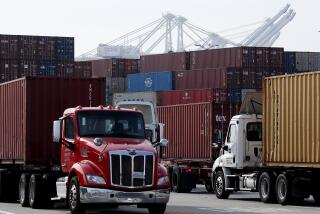Jacked-up vehicles raise safety, enforcement questions
- Share via
Baffled by the number of giant, jacked-up pickups and sport utility vehicles he sees traveling on public roads, a Laguna Beach reader asks why police aren’t cracking down.
“My family is at risk when I am following one of these vehicles,” Robert Minck said.
Indeed, if the bumpers have been removed and the height of the truck has been raised above legal standards, a collision could prove deadly.
“The first contact of my car with their vehicle would be either at windshield level or when my bumper hits their rear axle,” Minck said.
He’s right.
Some of these tall trucks could steamroll over most passenger vehicles -- and they have, said Clarence Ditlow, director of the Center for Auto Safety in Washington.
Police should approach the problem of on-street use of too-tall vehicles as “seriously as they take red-light running and drunk driving,” he said.
California limits the height of a modified vehicle by measuring from the ground to the lowest point of the frame.
For example, when a Ford Excursion comes off the assembly line and is sold, the distance between the ground and the frame is about 14 1/2 inches. But the law allows big vehicles such as the Excursion and the Chevy Suburban -- which can weigh up to 10,000 pounds -- to be lifted so there is as much as 31 inches between the ground and the frame.
The ground-to-frame limit for most passenger cars is 23 inches. Small trucks, including minivans, have a limit of 27 inches. For larger trucks of as much as 7,500 pounds gross weight -- a Ford F150 or a Chevy Silverado -- the limit is 30 inches.
Vehicles that exceed those limits cannot legally be driven on public roads. If an owner intends to go off-roading in the desert with a vehicle jacked up to exceed the limits, it is supposed to be towed to the off-road destination.
Serious off-road enthusiasts buy lift kits and giant tires to equip their vehicles for their outdoor adventures.
The problem is that some vehicles modified to look like off-roaders never venture from city streets.
For their owners, the extra height is an automotive style statement. The message, apparently, is that the bigger my truck, the tougher I am.
But whether drivers are using lift kits to raise vehicles several feet above stock height or adding greatly oversized tires to gain additional lift, the modification can pose serious safety risks, said David Champion, director of automotive testing for Consumer Reports magazine.
Big trucks and SUVs already are susceptible to rollovers because of their high centers of gravity. Raising the vehicle even higher further compromises its handling, Champion said.
National Highway Traffic Safety Administration tests have shown that just adding passengers and cargo to a SUV riding at stock height can double the rollover risk.
And adding oversized tires that have more grip than stock tires doesn’t help, he said. The increased grip and extra height increase the risk of rollover, he said. Bigger tires are heavier, too, and that adds to a vehicle’s emergency stopping distance.
But targeting potentially unsafe monster trucks driven illegally on city streets and highways doesn’t appear to be high on the list of police priorities.
“We don’t get involved much with that.... Our job is to catch criminals,” said Jason Lee, a spokesman for the Los Angeles Police Department. Using a modified vehicle that is not street legal for city driving is a minimal offense compared with driving under the influence of alcohol or drugs, he said.
The California Highway Patrol insists that its officers work hard to enforce the laws regarding vehicle height because it is a safety issue.
Yet neither the CHP nor NHTSA keep numbers on how many modified vehicles are cited or are involved in accidents.
All new vehicles produced and sold in the United States must comply with federal safety standards promulgated by NHTSA. But once a vehicle is purchased, it falls under state and local jurisdiction, so each state can have its own regulations regarding modification of trucks and autos.
In California, violators of height limits can be cited for using unsafe equipment. But auto safety advocates believe a “fix-it” ticket isn’t tough enough to stop drivers from flouting the law.
California’s height limits allow owners to change tire size or modify the vehicle “within reason,” said Steve Mazor, an automotive expert with the Automobile Club of Southern California.
The problem is that “a lot of the vehicles we see are raised quite a bit higher than the limit and are illegally being driven on public roads,” he said.
The growing popularity of these extreme vehicles has resulted in an increasing number of complaints from drivers who say they fear for their safety if they get into an accident with these oversized pickups and SUVs, Mazor said.
The Auto Club also hears concerns about dangerous headlight glare from jacked-up trucks.
“It makes sense to step up enforcement,” Mazor said.
Candysse Miller, director of the Insurance Information Network in Los Angeles, agrees.
“It’s scary. One of these large, lifted pickup trucks pulled up next to my car recently. Its massive tires were at eye level when I looked out my window. I felt like I was next to a jetliner.”
Jeanne Wright responds
* in this column to automotive questions of general interest. Write to Your Wheels, Business Section, Los Angeles Times, 202 W. 1st St., Los Angeles, CA 90012. E-mail: jeanrite@aol.com.






